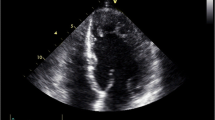Abstract
Left ventricle noncompaction (LVNC) is a clinically heterogeneous disorder. Although several genetic mutations have been reported, only a little is known about its genotype–phenotype correlation. We report two cases of LVNC with different mutations and different clinical courses for each. Case 1 was a 15-year-old boy with atrial septum defect and pulmonary valve stenosis. He was diagnosed as LVNC when he was 3 years old, but his cardiac function was maintained and no medication was necessary. A 432 kb deletion in chromosome 8p 23.1, including GATA4, was found. Case 2 was a boy who was referred to our hospital at the age 6 for apparent right ventricle hypertrophy in electrocardiogram carried out for screening. We recognized severe pulmonary hypertension (PH) and LVNC with attenuated cardiac diastolic function and fair systolic function. In spite of medications for both heart failure and PH, the response was poor. A genetic investigation revealed a point mutation at exon 6 of TBX20, c.655-2A>G.
You have full access to this open access chapter, Download conference paper PDF
Similar content being viewed by others
Keywords
Left ventricle noncompaction (LVNC) is a clinically heterogeneous disorder. Although several genetic mutations have been reported, only a little is known about its genotype–phenotype correlation. We report two cases of LVNC with different mutations and different clinical courses for each. Case 1 was a 15-year-old boy with atrial septum defect and pulmonary valve stenosis. He was diagnosed as LVNC when he was 3 years old, but his cardiac function was maintained and no medication was necessary. A 432 kb deletion in chromosome 8p 23.1, including GATA4, was found. Case 2 was a boy who was referred to our hospital at the age 6 for apparent right ventricle hypertrophy in electrocardiogram carried out for screening. We recognized severe pulmonary hypertension (PH) and LVNC with attenuated cardiac diastolic function and fair systolic function. In spite of medications for both heart failure and PH, the response was poor. A genetic investigation revealed a point mutation at exon 6 of TBX20, c.655-2A>G.
Both GATA4 and TBX20 have been reported to cause LVNC, but their clinical courses are not well known. Blinder et al. reported a case with GATA4 mutation [1], presenting a normal cardiac function. While Wang et al. reported genetic pathogenic variants to be independent risk factors for adverse events [2], there may be some relatively favorable mutations as our case1 and the report by Blinder et al. GATA4 is known as one of the earliest-expressed transcriptional factors in cardiac progenitor cells, and the expression continues throughout life in cardiomyocytes. It concerns to differentiation of myocardium together with TBX5, but how and when it affects myocardium compaction is unknown. In case 2, the severe PH could not be explained only by passive etiology, and pulmonary arterial hypertension also existed. TBX20 is related to various cardiac disorders including cardiomyopathy, intracardiac septal defects and abnormal valvulogenesis. Although the relation between the TBX20 mutation and PH was not clear in our case, it is interesting that Edwin et al. reported a familial case of dilated cardiomyopathy (DCM) with TBX20 mutation with primary PH [3]. Provided that both DCM and LVNC fall in a spectrum of cardiomyopathy, association of PH might be a key to find the function of TBX20 in these similar cases.
In summary, we report two cases of LVNC, one with GATA4 deletion and slight symptoms and the other with TBX20 mutation with severe PH and diastolic dysfunction, which were resistant to treatments.
References
Blinder JJ, et al. Noncompaction of the left ventricular myocardium in a boy with a novel chromosome 8p 23.1 deletion. Am J Med Genet. 2011;155A(9):2215–20.
Wang C, et al. A wide and specific spectrum of genetic variants and genotype-phenotype correlations revealed by next-generation sequencing in patients with left ventricular noncompaction. J Am Heart Assoc. 2017;6(9):e006210.
Edwin PK, et al. Mutations in cardiac T-Box factor gene TBX20 are associated with diverse cardiac pathologies, including defects of septation and valvulogenesis and cardiomyopathy. Am J Hum Genet. 2007;81(2):280–91.
Author information
Authors and Affiliations
Corresponding author
Editor information
Editors and Affiliations
Rights and permissions
Open Access This chapter is licensed under the terms of the Creative Commons Attribution 4.0 International License (http://creativecommons.org/licenses/by/4.0/), which permits use, sharing, adaptation, distribution and reproduction in any medium or format, as long as you give appropriate credit to the original author(s) and the source, provide a link to the Creative Commons license and indicate if changes were made.
The images or other third party material in this chapter are included in the chapter's Creative Commons license, unless indicated otherwise in a credit line to the material. If material is not included in the chapter's Creative Commons license and your intended use is not permitted by statutory regulation or exceeds the permitted use, you will need to obtain permission directly from the copyright holder.
Copyright information
© 2020 The Author(s)
About this paper
Cite this paper
Nogimori, Y. et al. (2020). Genetic Assessments for Clinical Courses of Left Ventricle Noncompaction. In: Nakanishi, T., Baldwin, H., Fineman, J., Yamagishi, H. (eds) Molecular Mechanism of Congenital Heart Disease and Pulmonary Hypertension. Springer, Singapore. https://doi.org/10.1007/978-981-15-1185-1_64
Download citation
DOI: https://doi.org/10.1007/978-981-15-1185-1_64
Published:
Publisher Name: Springer, Singapore
Print ISBN: 978-981-15-1184-4
Online ISBN: 978-981-15-1185-1
eBook Packages: MedicineMedicine (R0)




